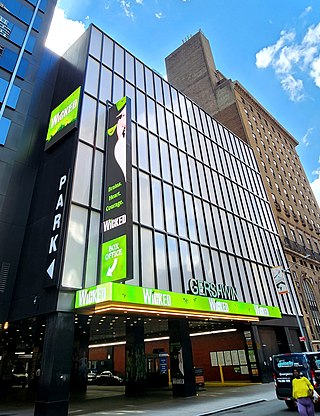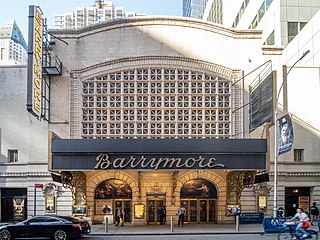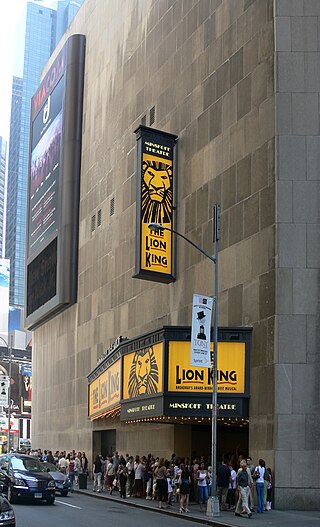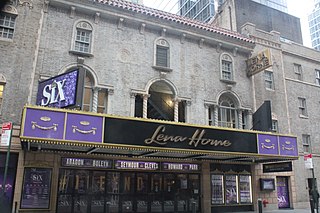Related Research Articles

The Winter Garden Theatre is a Broadway theatre at 1634 Broadway in the Midtown Manhattan neighborhood of New York City. It opened in 1911 under designs by architect William Albert Swasey. The Winter Garden's current design dates to 1922, when it was completely remodeled by Herbert J. Krapp. Due to the size of its auditorium, stage, and backstage facilities, it is favored for large musical productions. It has 1,600 seats and is operated by The Shubert Organization. The auditorium interior is a New York City landmark.

The Imperial Theatre is a Broadway theater at 249 West 45th Street in the Theater District of Midtown Manhattan in New York City. Opened in 1923, the Imperial Theatre was designed by Herbert J. Krapp and was constructed for the Shubert brothers. It has 1,457 seats across two levels and is operated by The Shubert Organization. The auditorium interior is a New York City designated landmark.
George Hearn is an American actor and singer, primarily in Broadway musical theatre. Some of his roles include Albin in La Cage aux Folles, the title role in Sweeney Todd: The Demon Barber of Fleet Street, Max von Mayerling in Sunset Boulevard, Mr. Otto Frank in The Diary of Anne Frank, and The Wonderful Wizard of Oz in Wicked.

The Neil Simon Theatre, originally the Alvin Theatre, is a Broadway theater at 250 West 52nd Street in the Theater District of Midtown Manhattan in New York City. Opened in 1927, the theater was designed by Herbert J. Krapp and was built for Alex A. Aarons and Vinton Freedley. The original name was an amalgamation of Aarons's and Freedley's first names; the theater was renamed for playwright Neil Simon in 1983. The Neil Simon has 1,467 seats across two levels and is operated by the Nederlander Organization. Both the facade and the auditorium interior are New York City landmarks.

The August Wilson Theatre is a Broadway theater at 245 West 52nd Street in the Theater District of Midtown Manhattan in New York City. Opened in 1925, the theater was designed by C. Howard Crane and Kenneth Franzheim and was built for the Theatre Guild. It is named for Pulitzer Prize-winning playwright August Wilson (1945–2005). The August Wilson has approximately 1,225 seats across two levels and is operated by Jujamcyn Theaters. The facade is a New York City designated landmark.

The Al Hirschfeld Theatre, originally the Martin Beck Theatre, is a Broadway theater at 302 West 45th Street in the Theater District of Midtown Manhattan in New York City. Opened in 1924, it was designed by G. Albert Lansburgh in a Moorish and Byzantine style and was constructed for vaudevillian Martin Beck. It has 1,404 seats across two levels and is operated by Jujamcyn Theaters. Both the facade and the interior are New York City landmarks.

The St. James Theatre, originally Erlanger's Theatre, is a Broadway theater at 246 West 44th Street in the Theater District of Midtown Manhattan in New York City. Opened in 1927, it was designed by Warren and Wetmore in a neo-Georgian style and was constructed for A. L. Erlanger. It has 1,709 seats across three levels and is operated by Jujamcyn Theaters. Both the facade and the auditorium interior are New York City landmarks.

The Shubert Theatre is a Broadway theater at 225 West 44th Street in the Theater District of Midtown Manhattan in New York City. Opened in 1913, the theater was designed by Henry Beaumont Herts in the Italian Renaissance style and was built for the Shubert brothers. Lee and J. J. Shubert had named the theater in memory of their brother Sam S. Shubert, who died in an accident several years before the theater's opening. It has 1,502 seats across three levels and is operated by The Shubert Organization. The facade and interior are New York City landmarks.

The Gershwin Theatre is a Broadway theater at 222 West 51st Street, on the second floor of the Paramount Plaza office building, in the Midtown Manhattan neighborhood of New York City. Opened in 1972, it is operated by the Nederlander Organization and is named after brothers George and Ira Gershwin, who wrote several Broadway musicals. The Gershwin is Broadway's largest theater, with approximately 1,933 seats across two levels. Over the years, it has hosted musicals, dance companies, and concerts.

The Richard Rodgers Theatre is a Broadway theater at 226 West 46th Street in the Theater District of Midtown Manhattan in New York City. Opened in 1925, it was designed by Herbert J. Krapp and was constructed for Irwin Chanin. It has approximately 1,400 seats across two levels and is operated by the Nederlander Organization. Both the facade and the auditorium interior are New York City landmarks.
Judy Kaye is an American singer and actress. She has appeared in stage musicals, plays, and operas. Kaye has been in long runs on Broadway in the musicals The Phantom of the Opera, Ragtime, Mamma Mia!, and Nice Work If You Can Get It.

The Circle in the Square Theatre is a Broadway theater at 235 West 50th Street, within the basement of Paramount Plaza, in the Midtown Manhattan neighborhood of New York City. The current Broadway theater, completed in 1972, is the successor of an off-Broadway theater of the same name, co-founded around 1950 by a group that included Theodore Mann and José Quintero. The Broadway venue was designed by Allen Sayles; it originally contained 650 seats and uses a thrust stage that extends into the audience on three sides. The theater had 751 seats as of 2022.

The Broadway Theatre is a Broadway theater at 1681 Broadway in the Theater District of Midtown Manhattan in New York City. Opened in 1924, the theater was designed by Eugene De Rosa for Benjamin S. Moss, who originally operated the venue as a movie theater. It has approximately 1,763 seats across two levels and is operated by The Shubert Organization. The Broadway Theatre is one of the few Broadway theaters that is physically on Broadway.

The Ethel Barrymore Theatre is a Broadway theater at 241 West 47th Street in the Theater District of Midtown Manhattan in New York City. Opened in 1928, it was designed by Herbert J. Krapp in the Elizabethan, Mediterranean, and Adam styles for the Shubert family. The theater, named in honor of actress Ethel Barrymore, has 1,058 seats and is operated by the Shubert Organization. Both the facade and the auditorium interior are New York City landmarks.

The Gerald Schoenfeld Theatre, formerly the Plymouth Theatre, is a Broadway theater at 236 West 45th Street in the Theater District of Midtown Manhattan in New York City. Opened in 1917, the theater was designed by Herbert J. Krapp and was built for the Shubert brothers. The Schoenfeld Theatre is named for Gerald Schoenfeld, longtime president of the Shubert Organization, which operates the theater. It has 1,079 seats across two levels. Both the facade and the auditorium interior are New York City landmarks.

The Nederlander Theatre is a Broadway theater at 208 West 41st Street in the Theater District of Midtown Manhattan in New York City. Opened in 1921, it was designed by William Neil Smith for theatrical operator Walter C. Jordan. It has around 1,235 seats across two levels and is operated by the Nederlander Organization. Since 1980, it has been named for American theater impresario David Tobias Nederlander, father of theatrical producer James M. Nederlander. It is the southernmost Broadway theater in the Theater District.

The Music Box Theatre is a Broadway theater at 239 West 45th Street in the Theater District of Midtown Manhattan in New York City. Opened in 1921, the Music Box Theatre was designed by C. Howard Crane in a Palladian-inspired style and was constructed for Irving Berlin and Sam H. Harris. It has 1,025 seats across two levels and is operated by The Shubert Organization. Both the facade and the auditorium interior are New York City landmarks.

The Minskoff Theatre is a Broadway theater on the third floor of the One Astor Plaza office building in the Theater District of Midtown Manhattan in New York City. Opened in 1973, it is operated by the Nederlander Organization and is named after Sam Minskoff and Sons, the building's developers. There are approximately 1,710 seats in the auditorium, spread across an orchestra level and a balcony. Over the years it has served as host to musicals, dance companies, and concerts.

The Lunt-Fontanne Theatre, originally the Globe Theatre, is a Broadway theater at 205 West 46th Street in the Theater District of Midtown Manhattan in New York City. Opened in 1910, the Lunt-Fontanne Theatre was designed by Carrère and Hastings in the Beaux-Arts style for Charles Dillingham. The theater is named after theatrical couple Alfred Lunt and Lynn Fontanne; its original name was inspired by that of the Globe Theatre, London's Shakespearean playhouse. The current configuration of the interior, dating to 1958, has about 1,519 seats across two levels and is operated by the Nederlander Organization. The facade is a New York City landmark.

The Lena Horne Theatre is a Broadway theater at 256 West 47th Street in the Theater District of Midtown Manhattan in New York City. Opened in 1926, it was designed by Herbert J. Krapp in a Spanish Revival style and was constructed for Irwin Chanin. It has 1,069 seats across two levels and is operated by the Nederlander Organization. Both the facade and the auditorium interior are New York City landmarks.
References
- ↑ Playbill 1981 Bio Cast Listaccessed 07/17/2023
- ↑ The Broadway League. "Marlowe – Broadway Musical – Original | IBDB". www.ibdb.com. Retrieved 2020-07-23.
- ↑ "2 Dec 1981, 57 - Daily News at Newspapers.com". Newspapers.com. Retrieved 2020-07-23.
- ↑ Rich, Frank. "Theater. 'Marlowe' A Rock Musical" The New York Times, October 13, 1981